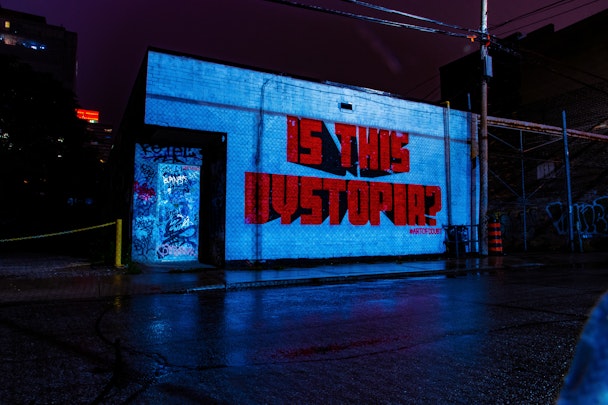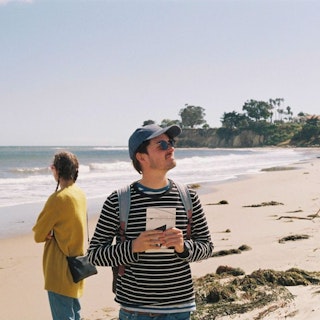'It’s a crazy, scary, exciting time' – Dentsu’s cultural futurists on prediction, optimism and dystopia
Dentsu recently released their Creative Trends 2022 report, diagnosing 5 themes comprising a “new worlds order”. But what goes into creating the landmark reports that arrive as shiny pdfs in our inboxes? How do you boil down 8 billion lives into 5 trends? When looking to the future from a world that can already feel aflame, how do you strike a balance between optimism and pessimism? We sat down with two of the report’s authors to find out.

The 'metaverse' was conceived in dystopic fiction - but is there still space for optimism? / alex kristanas via Unsplash
‘The practice of cultural futurism’ may sound like a governmental department in an Arthur C Clarke novel, but it’s a real (if nascent) practice in Dentsu’s strategy arm, spearheaded by cultural futurist Keely Adler.
The kind of work Adler does will be familiar to strategists: trend development and “helping brands to understand themselves in context” to let them “step outside the four walls of their company”.
Calling that work ‘futurism’ says a lot about what clients are looking for. “Many of us don’t have the time or the headspace to get out of the weeds and really think from the outside-in, but increasingly our ability to lead our clients really depends on helping inspire them with this vision of what the future can look like and the role they can play in it”.
Generation also-me
Adler is one of 30 contributors to Dentsu’s Creative Trends 2022 report, drawn from their global network of agencies. The report has a conspicuous focus on Gen Z and the things they care about; it’s peppered with essays from young creative workers across the world. “Some of the change that’s happening in the world – you really need people who are of that generation to speak to it with innate understanding of the platforms,” says Patricia McDonald, Dentsu Creative’s head of strategy.
Dentsu are serious about listening to Gen Z voices. This year, they unveiled DentsuZ, a cross between an agency, a focus group, and a TikTok house staffed exclusively by people born after 1995, tasked with understanding the cultural experience of kids in China and beyond.
Likewise, Dentsu agency Isobar Italy recently launched a shopfront on Roblox.
Consistency is dead
The new way of stylizing attention-grabbing collaborations like advertising agencies launching virtual premises inside games aimed at young children is with an ‘x’, signifying the multiplicatory potential of these collisions of worlds: Gucci x The North Face; Fortnite x Balenciaga (and, indeed, Simpsons x Balenciaga); BTS x McDonald's.
These collaborations would have been unlikely a year or two ago, says McDonald – indeed, “we would have said that those are a poor brand fit for a collaboration… but because this is a generation that’s been raised on memes, on splicing things together that don’t belong, that cognitive dissonance isn’t there.”
The guardrails are off, then – at least for some. For Adler “flexibility rooted in authenticity” is a prize won by brands with a strong enough sense of who they are that they can afford a little play.
The decentralized self
Mash-ups and remixes have been a part of the internet’s vision of itself since day dot(com). But for Adler, Gen Z are the first generation to truly embrace mashed-up identity.
“You have this nichification of identity intersecting with the nichification of media and community in a way that means you can celebrate and embrace all these different facets of yourself,” she says. “You can see yourself in the chaotic – if slightly creepy – beauty of the TikTok algorithm. You can find a Substack and a Discord that feels like it speaks to you specifically.”
These digital spaces, she says, allow us to “embrace context and contradiction and change who we are and embrace the different sides of us from moment to moment, which is much more true to who we are as people.”
Does the emperor of the metaverse wear any clothes?
Is the cheerleading for the utopian potential of alternate realities, cryptocurrencies and fan communities justified by actual improvements, current or coming, in people’s lives? Or are we just in for another round of cyberoptimism?
“I’m old enough to remember Second Life,” says McDonald. “I think there are some things that are different this time round. When people were popping up on Second Life, there wasn’t this huge gaming industry generating the kind of revenues that it is. There wasn’t this established convention of people paying real money for virtual product”.
And they are: the report estimates $11b spent on NFTs this year; wild tales abound, from $4,000 for a virtual Gucci handbag to hundreds of thousands for virtual furniture designed by Andres Resinger.
“The great invariants of human nature”
The boom in markets for virtual goods has already changed digital spaces. “When I was younger, I would wear cool sneakers at recess. Now, that happens in the digital world, where you show off the cool item you purchased,” says Mythical Games’ Rudy Koch in the report.
We face a choice between optimism and pessimism – is that a cool opportunity to exercise your individuality in the digital realm, or a regrettable recreation of the status effects of wealth in a digital world that once dreamed of plenty and equality?
“We don’t leave any of our real-world issues or baggage behind us when we go into that space,” says McDonald. “As we spend in these virtual spaces, all the issues we have in the real world are brought with us – but there’s also an opportunity to tackle those issues”. Adler agrees: paraphrasing French futurist Noémie Aubron, she says, “we often think of a trend as something new but more than anything it’s this alignment between this thing that’s emerging, the spirit of the moment, and the great invariants of human nature”.
Optimism, pessimism, and cynicism
McDonald’s experience living in the balance between optimism and pessimism feels universal: “there are days when you wake up and you think, ‘wow this is incredibly exciting’, and there are days when you think ‘oh my god, what hellscape is this?”
How, then, can futurists (and the rest of us who, regrettably, must live in the present) strike the right balance? “It’s really easy to be cynical and say ‘why on earth would anyone pay money for a jpeg?’ But they’re not paying for a jpeg, any more than when they buy a beautiful painting they’re paying for canvas and oil paint. They’re paying for a certain kind of emotion, a kind of creativity, a sense of the values embedded in that item.”
Perhaps some of our worries about coming technologies ignore just how much always seems to stay the same. “If you strip things back to basics, what we’ve always done is imbue things with way more meaning than they have any right to have - a pair of trainers or jeans or a car. That allows you to charge a premium for it. That’s branding. We shouldn’t really be surprised when we look at the virtual world and see that people are paying a fortune for pixels. It’s just branding. That’s what we’ve always done.”
Content created with:

Dentsu
Dentsu Inc. is a Japanese international advertising and public relations joint stock company headquartered in Tokyo. Dentsu is currently the largest advertising...
Find out more
